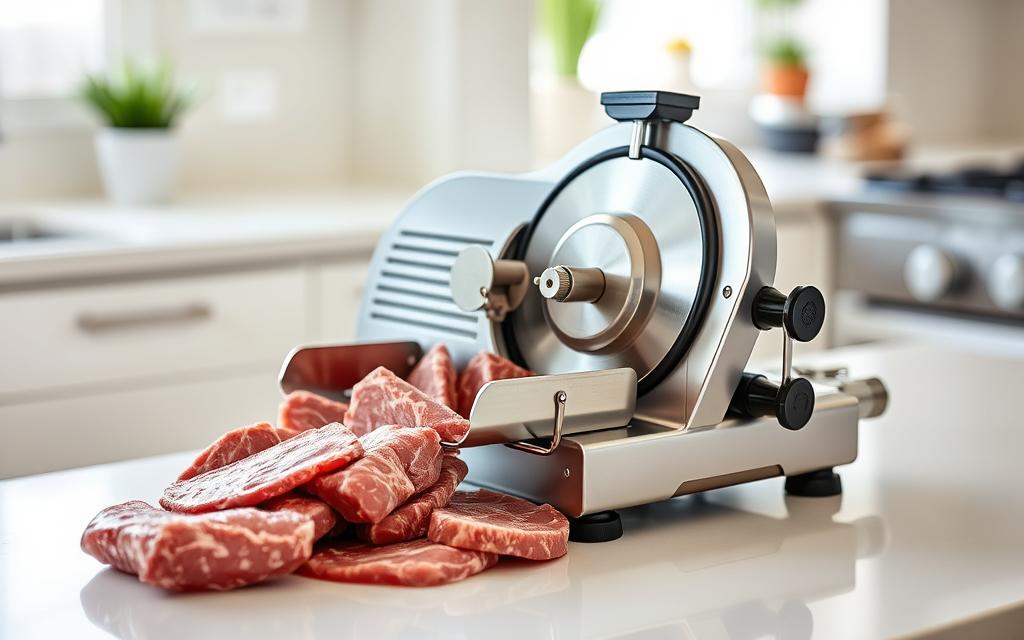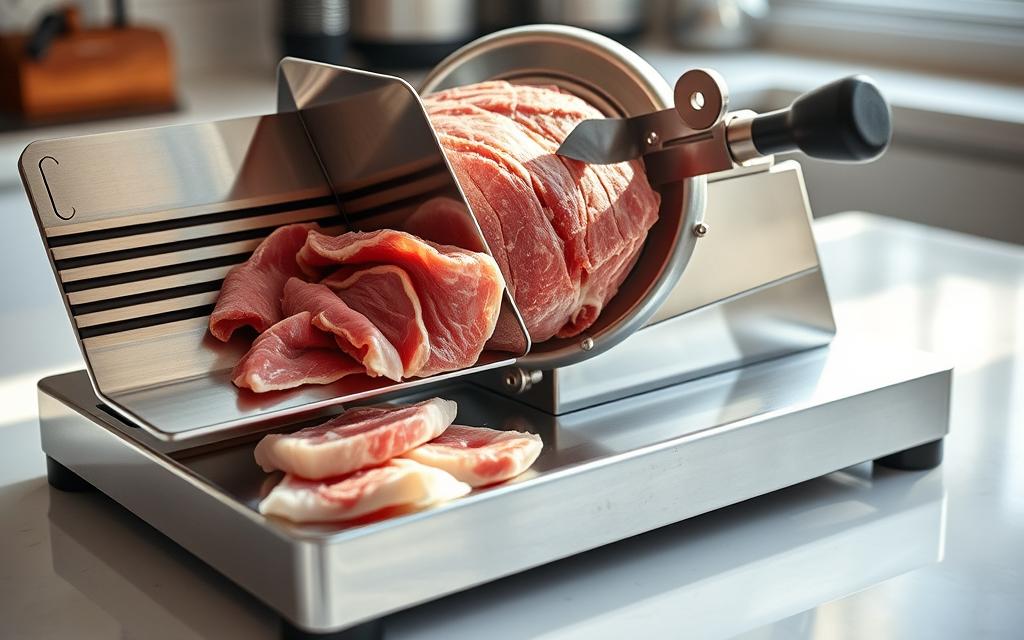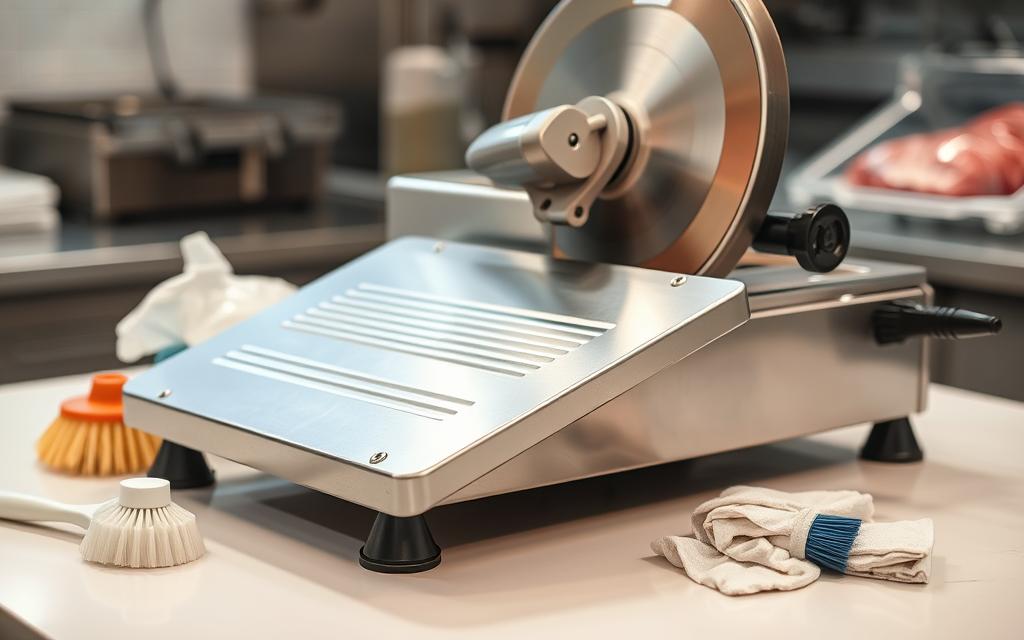When it gets cold, we often want warm, comforting meals. Slicing frozen meat can seem hard. But, a good meat slicer makes it easy.
This guide will teach you how to slice frozen meat with a meat slicer. You’ll learn about different slicers and how to use them. Soon, you’ll be making tasty dishes with ease.

Key Takeaways
- Meat slicers are versatile kitchen tools suitable for slicing frozen meat, cheese, and vegetables.
- Electric meat slicers are common in commercial settings, while manual options are popular for home use.
- Proper operation and maintenance of a meat slicer are crucial for safety and efficiency.
- Frozen meat slicing requires specialized slicers designed to handle the hardness of frozen products.
- Manconi offers a range of professional-grade frozen meat slicers to meet the needs of delis, supermarkets, and food stores.
Understanding Your Meat Slicer
Choosing the right meat slicer is key for getting precise, consistent slices. It also ensures food safety for sliced meats. There are three main types: light-duty, medium-duty, and heavy-duty. Each is for different needs and cutting tasks.
Types of Meat Slicers Available
- Light-duty meat slicers are great for slicing meat or veggies for an hour or less daily. They’re not for frozen items.
- Medium-duty meat slicers handle several hours of use daily. They can slice cheese for up to 30 minutes.
- Heavy-duty meat slicers are for big restaurants. They have strong motors and can slice frozen meat.
Features to Look For
When picking a meat slicer, look for adjustable thickness, safety guards, and easy-to-clean parts. Electric slicers are convenient and powerful. Manual meat slicers are cheaper and good for small uses.
| Feature | Benefit |
|---|---|
| Adjustable thickness settings | Allows for precise control over slice thickness, accommodating different food types and personal preferences. |
| Safety guards | Helps prevent injuries by shielding the blade and other moving parts during operation. |
| Easy-to-clean components | Facilitates commercial meat slicer maintenance and ensures proper sanitation for food safety. |
Knowing about the different meat slicers and their features helps you choose wisely. This ensures your commercial meat slicer maintenance needs and food prep are met.
Benefits of Slicing Frozen Meat
Slicing frozen meat has many advantages. It lets you control the slice thickness better. This is great for even cooking and presentation in dishes.
It also makes portioning meals easy. Pre-sliced meat is simple to portion and store. This helps reduce waste and makes meal prep quicker.
Improved Control Over Thickness
Freezing meat gives you more control over slice thickness. You can make slices just right for sandwiches, stir-fries, or other recipes.
Convenient Portioning for Meals
Pre-slicing meat makes portioning meals simple. It helps avoid food waste and ensures the right serving size is ready. This saves time and effort in meal prep.
| Meat Slicer Type | Recommended Usage | Suitable for Frozen Meat? |
|---|---|---|
| Light-duty | Low-volume use, typically under 1 hour per day | No, not recommended for slicing frozen items |
| Medium-duty | Several hours of use per day, suitable for slicing cheese for up to 30 minutes | No, not suitable for slicing frozen meat |
| Heavy-duty | Capable of slicing frozen meat, commonly used in large restaurants | Yes, suitable for slicing frozen meat |
While slicing frozen meat has its perks, some experts warn against using electric slicers on fully frozen meat. The ice can harm the blade. Partially thawed meat might be better for thin, even slices and keeping the meat’s texture.
Preparing Frozen Meat for Slicing
When slicing frozen meats, picking the right cut and thawing it right are key. You want even, consistent slices that keep your food safe and tasty.
Selecting the Right Cut
Choose cuts that fit well on your meat slicer’s tray. Go for sizes that are easy to handle. This way, you get even slices for dishes like soups, tacos, and wraps.
Thawing: A Key Step
Some say slice meat when it’s fully frozen, but others prefer it partially thawed. This makes slicing better and protects your slicer’s blade. Let the meat thaw for about 30 minutes to keep it from freezing solid.
Keeping food safe is crucial. Make sure to clean and sanitize your slicer well. This prevents cross-contamination and keeps your food safe.
“Thinly-sliced pork in the Spicy Pork Bowl with Greens and Carrots takes just two minutes to cook.”
Setting Up Your Meat Slicer
Before you start slicing frozen meat, make sure your deli meat slicer is ready. Place it on a stable, level surface. Also, turn on the safety features like the blade guard and food pusher to keep your hands safe.
Safety Features to Engage
- Blade guard: This feature covers the exposed blade, preventing accidental contact.
- Food pusher: Use the food pusher to guide the meat through the slicer, keeping your hands at a safe distance from the blade.
- On/off switch: Always turn the slicer off when not in use or when adjusting the settings.
Adjusting the Thickness Setting
The thickness setting is key for perfect slices. Check your user manual for how to adjust the knob or lever. Try different settings to find the right thickness for your frozen meat. Thinner slices need more care to avoid tearing.
To stop sliced meat from sticking, put wax paper under where the slices fall. This makes cleaning up a breeze.
Always put safety first when using a deli meat slicer. Keep your hands away from the blade and use the food pusher. With the right setup and care, you’ll be slicing frozen meat like a pro soon.
Techniques for Cutting Frozen Meat
Slicing frozen meat can be tricky, but with the right methods, you can get even and clean cuts. It’s all about being patient and letting your meat slicer do its job.
Best Practices for Even Slices
- Use smooth, consistent motions when pushing the meat through the slicer. Avoid applying too much pressure, as this can lead to uneven cuts or damage the machine.
- Partially freeze the meat before slicing to make the process easier and cleaner. This helps achieve the desired consistency and flexibility for cutting.
- Cut the meat following the muscle fiber direction to ensure softer and more tender slices after cooking.
- Consider using an electric knife or a heavy-duty knife with a serrated edge for smooth, clean cuts through frozen meat.
Common Mistakes to Avoid
- Do not slice meat with bones, as this can damage the blade of your meat slicer.
- Avoid thawing and refreezing the meat, as this can compromise the quality and safety of the product.
- Steer clear of placing frozen meat directly on heat, as this can lead to dehydration, dryness, and burnt edges.
- Be cautious when cutting frozen meat to prevent potential injuries, and consider using safety gloves if necessary.
Remember, patience and practice are key when it comes to mastering the art of slicing frozen meat with a meat slicer. By following these techniques and avoiding common pitfalls, you can ensure consistently great results for your culinary creations.
Cleaning and Maintaining Your Meat Slicer
Keeping your commercial meat slicer clean and well-maintained is key for food safety and performance. As a pro in the food service world, you understand the importance of keeping your gear in top shape. This ensures you serve your customers the best, safest sliced meats.
Importance of Regular Maintenance
Regular upkeep is vital for your meat slicer’s life and efficiency. Manconi, a top meat slicer maker, has worked with food pros for over sixty years. They focus on making durable, reliable slicers. It’s also important to train your team well, to avoid accidents and keep the slicer running smoothly.
Don’t forget to sharpen your slicer’s blade regularly. A sharp blade means precise, even cuts every time. Manconi also offers custom meat slicers for the catering world. This ensures your slicer fits your specific needs perfectly.
Safe Cleaning Practices
- Unplug the slicer and take it apart for a deep clean.
- Use water and a mild detergent to clean all parts, like the blade guard and food trays.
- Wear gloves to protect your hands while cleaning.
- Clean and sanitize the slicer every 4 hours of use or after each use if it’s not used often, as the FDA suggests.
- Do a deep clean at the end of each day, taking everything apart and washing and sanitizing each piece.
Keeping your meat slicer clean and working well is crucial for food safety. It stops food debris from building up, which can attract harmful bacteria. By following these maintenance tips, you’ll keep your slicer safe and efficient. This means you can give your customers the best sliced meats.
Storing Sliced Frozen Meat
Keeping your sliced frozen meat fresh and safe is key. To keep your meat in top shape, explore these packaging and labeling tips.
Packaging Options for Freshness
Use airtight containers or quality freezer bags to store sliced frozen meat. This reduces air contact and stops freezer burn. Remove air from the packaging to seal it tightly. This keeps the meat’s flavor and texture fresh.
This step is vital for food safety for sliced meats and keeping your frozen meat preparation quality high.
Labeling and Dating Slices
Labeling your sliced frozen meat is crucial. Make sure to write the meat type and the date it was sliced. This helps you manage your frozen meat and ensures you use the oldest first.
Good labeling also helps you plan meals and know what you have.
| Packaging Method | Recommended Storage Time |
|---|---|
| Airtight Containers | 3-6 months |
| Freezer Bags (with air removed) | 2-3 months |
By using these storage and labeling tips, you can keep your sliced frozen meat fresh and safe. This way, you’ll enjoy the best quality and flavor when you’re ready to eat it.
Troubleshooting Slicing Issues
Slicing frozen meat with a meat slicer can sometimes present challenges, but with the right techniques and adjustments, you can overcome them. Let’s dive into some common issues and solutions to ensure a smooth and consistent slicing experience.
Dealing with Sticking Meat
One of the most frequent problems when slicing frozen meat is the meat sticking to the blade. This can happen when the meat is not sufficiently thawed or the blade is not sharp enough. To prevent this, make sure to partially thaw the meat before slicing, allowing it to reach a temperature where it’s pliable but still firm. Also, keep your meat slicer blade well-maintained and sharpened to provide a clean, effortless cut.
Adjusting for Different Meats
Different types of meat may require slight adjustments to your slicing technique or thickness settings. For tougher cuts, such as beef or pork, you may need to slow down the slicing speed and increase the thickness setting to prevent the meat from shredding or tearing. On the other hand, more delicate meats, like chicken or fish, may require a thinner slice and a faster slicing motion for the best results.
If you notice uneven or shredded cuts, it could be a sign that it’s time to sharpen or replace the blade on your meat slicer. Regularly maintaining your equipment is crucial for achieving precise, uniform slices, no matter the type of meat you’re working with.
“Consistent slicing is key when dealing with frozen meat. With the right techniques and slicer adjustments, you can achieve professional-looking results every time.”
By following these troubleshooting tips and staying vigilant about the condition of your meat slicer, you’ll be able to overcome common slicing issues and deliver perfectly sliced frozen meat for your culinary creations. Remember, a well-maintained and properly adjusted meat slicer is the foundation for consistent, high-quality results.
Safety Tips While Slicing
When using a deli meat slicer, your safety is key. Wear the right gear and use careful techniques to avoid injuries. Follow simple safety tips for a safe and efficient slicing experience. This keeps your food safe and your operation smooth.
Using Proper Protective Gear
Always wear cut-resistant gloves when handling or cleaning the meat slicer. These gloves protect your hands from cuts. Also, make sure your clothes are tight and won’t get caught in the blade.
Avoiding Common Injuries
- Keep your fingers away from the blade at all times, using the food pusher to guide the meat through the slicer.
- Unplug the slicer when not in use and turn the thickness dial to zero to cover the blade.
- Never attempt to catch falling meat slices; let them drop onto the prepared surface to prevent injury.
By following these safety tips, you can greatly reduce the risk of accidents. This ensures a safe and efficient slicing experience. Remember, safety is crucial for a healthy kitchen environment.
Being careful and safety-focused is essential when using a deli meat slicer. By following these guidelines, you can slice meat safely. This prioritizes your well-being and maintains top food safety and slicer operation standards.
Enhancing Your Slicing Skills
Learning to slice frozen meat with a meat slicer takes time, but it’s worth it. It’s great for making charcuterie boards, meal prep, or finding the right thickness for recipes. Improving your meat slicing skills can really make a difference.
Practice Makes Perfect
Begin by slicing softer meats like deli ham or turkey. This will help you get used to the slicer’s controls. Then, move on to tougher, frozen cuts and try different thickness settings. Adjust the blade depth and speed to get the results you want.
As you get better, try slicing different meats. This includes tender pork tenderloin and beef brisket. Notice how the meat reacts to the slicer and adjust as needed. Regular practice will help you slice frozen meat with precision and confidence.
Useful Resources and Videos
Look online for resources to improve your meat slicing skills. Check the manufacturer’s guides or watch tutorial videos for your slicer model. Cooking forums and social media are also good places to learn from others.
Watching videos on meat slicing techniques can be very helpful. These videos show how to get even, consistent slices and share tips to avoid mistakes. Spend time learning from these resources to master slicing frozen meat with a meat slicer.
“Precision and consistency are key when slicing frozen meat. With practice and the right techniques, you can achieve restaurant-quality results in your own kitchen.”
Conclusion
Learning to slice frozen meat with a meat slicer can change your cooking game. By using the tips from this guide, you can get thin, even slices. These slices make your dishes look and taste better.
Recap of Key Points
Always keep safety first when using your meat slicer. Make sure all safety features are on and keep the slicer in good shape. Also, choose the right cut and thaw the meat properly for the best slices.
Encouragement for Trial
With a bit of practice, you’ll be slicing frozen meats like a pro. You’ll save time and money, and your dishes will get even better. So, go ahead and try out different ways to slice frozen meat. The effort will be worth it.





Leave a Reply